The Asymmetric Impact of Offshoring and Low-skill Immigration on Employment and Wages
The U.S. labor market has been strikingly polarized over the past three decades: employment growth was robust for both high- and low-skill occupations while jobs for middle-skilled workers tended to disappear. Real wages followed a different pattern. Wages for high-skill occupations increased robustly, while earnings of low- and middle-skilled workers remained subdued. In this paper, I briefly discuss some new research on this topic, which shows the important role that the emergence of offshoring and low-skill immigration may have played in this phenomenon.
Over the past three decades, the disappearance of jobs typically held by middle-skilled workers is particularly striking. This can be summarized in chart 1, which I reproduced using the same empirical strategy as in Autor and Dorn (2013). Chart 1A shows the change in the share of U.S. total employment for 318 nonfarm occupations during this period. Such occupations are ranked by skill on the horizontal axis, where the skill level is approximated by the mean (log) wage of workers in each occupation in 1980. The chart shows that the employment share of occupations held by middle-skilled workers diminished notably over the last three decades. Instead, employment gains were concentrated both in the high- and low-skill segments.
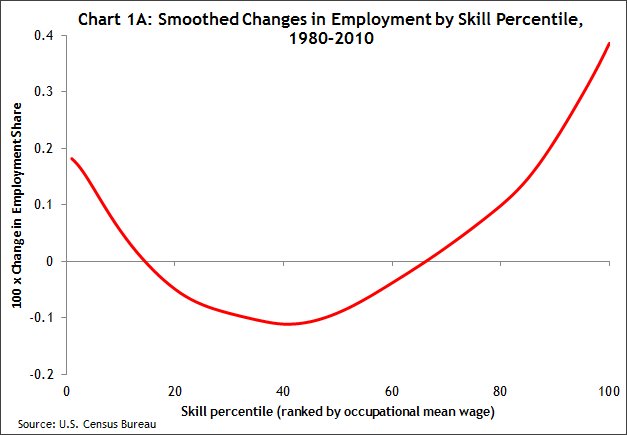
This so-called labor market polarization has been associated with job losses in occupations characterized by the performance of "routine" tasks, which are typically found in the middle of the skill distribution. Among these routine occupations are jobs ranging from blue-collar assignments in manufacturing to office and administrative support. These workers tend to follow well-defined repetitive procedures, which can be coded in computer software or executed by machines. As computers improve in quality and decline in price, middle-skill jobs tend to disappear.
In these circumstances, workers in nonroutine tasks have a critical comparative advantage. These nonroutine occupations can be divided in two categories: abstract and manual, with each category at the opposite tail of the skill distribution. Abstract tasks require creativity, problem solving, and persuasion; managers and professionals are in this category. Manual tasks require physical strength, in-person interactions, and situational adaptability. In this segment, we find mostly service occupations, which consist of assisting and caring for others, such as food service laborers, janitors, home health aides, and child care workers. Adding to this, chart 1B shows that the growth in "service occupations" explained practically all the employment gains for low-skilled workers during the last three decades. Put another way, the twist of the employment distribution at the low-skill tail becomes negligible in a counterfactual scenario in which employment in service occupations is held at its 1980 level.
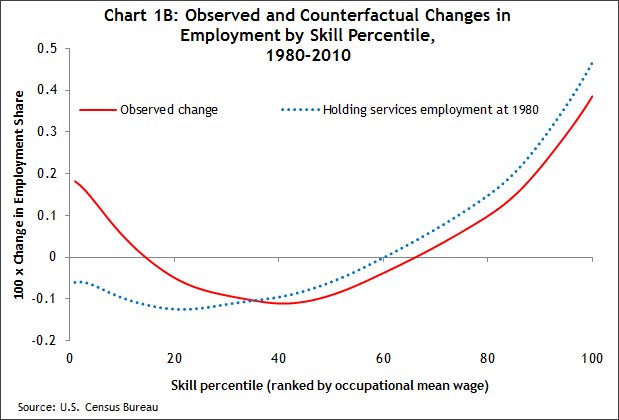
While routine-biased technological change is a compelling factor explaining the polarization, there may be other factors behind this phenomenon. One possibility is international trade. Job tasks typically held by middle-skilled workers are increasingly offshored overseas. As explained in Grossman and Rossi-Hansberg (2008), revolutionary advances in transportation and communications have recently transformed the nature of international trade. It now involves bits of value-added in different locations rather than the traditional exchange of finished goods. In Grossman and Rossi-Hansberg's words, we are witnessing a trade in tasks, rather than a trade in goods.
Instructions can be delivered instantaneously, and components of unfinished goods can move quickly and cheaply. This allows firms to incorporate labor inputs from other countries in the production process and exploit local specialization. So, for instance, U.S. high-skilled individuals in Silicon Valley can specialize in designing and marketing a brand-new high-tech device while other tasks can be completed in the rest of the world—for example, Thai technicians manufacture the hard drive, Chinese workers proceed with the final assembly, and Indian office workers provide help desk support. Those high-skilled individuals in the United States benefit from trade liberalization as the new high-tech device is sold globally; however, workers with lower skills are displaced.
Consistent with this theme, Ottaviano, Peri, and Wright (2013) show that labor tasks executed by middle-skilled workers are those that are typically offshored. In these circumstances, high-skilled individuals stand a better chance in the global marketplace and become relatively more productive, with their labor complemented by cheaper offshore labor. But that alone cannot explain the polarization, which is also defined by the improved employment prospects for those at the very bottom of the skill distribution.
In a new paper, I develop a stochastic growth model with international trade in tasks, where I claim that low-skilled workers are "protected" from the offshoring wave (see Mandelman 2013 for details). Tasks in many service occupations are only valuable for the consumer if they are performed where the service is delivered and are nontradable by definition. For instance, a bartender's service is only useful at a bar or restaurant. Not only is offshoring not a competitive threat, but as the incomes of high-skill individuals increase, the demand for personal services such as these also increases. Taken together, these factors can help explain the polarization.
Yet, one puzzling aspect of this labor market polarization is that it did not occur in a steady manner. As explained by Acemoglu and Autor (2010), from 1979 to 1989 employment growth was quantitatively monotone in occupation skill. Consequently, occupations at the bottom of the skill distribution declined in aggregate employment and the high-skill segment increased in aggregate employment. In contrast, from 1999 to 2007, employment growth was heavily concentrated at the bottom. That is, low-skill jobs expanded robustly, and the high-skill group stalled (see chart 2). A routine-biased technological change that steadily erases routine tasks, and equally favors nonroutine manual (low-skill) and abstract (high-skill) jobs, can hardly be reconciled with the evidence.
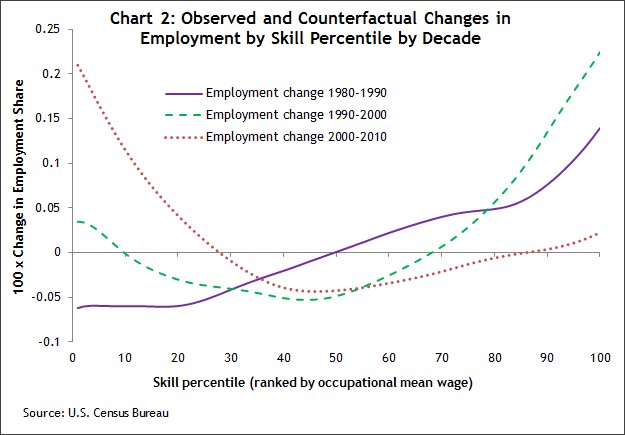
Instead, my model is suitable to study fluctuations over short- to medium-term horizons and can rationalize the evidence for each decade. Technological innovations can increase labor productivity but also magnify the productivity of those who are relatively more skilled and execute tradable tasks. This resembles a Balassa-Samuelson effect, which results in employment gains that are monotonic in skill. This scenario is consistent with the evidence in the 1980s, when offshoring was still marginal (see Firpo, Fortin, and Lemieux 2011). Instead, between the years 1999 and 2007, there was much debate about the sizable U.S. current account deficits, which were associated with foreigners running trade surpluses and accumulating international assets to finance a domestic consumption boom. My model shows that in such an event, the domestic economy would lean toward the production of nontradable tasks (such as low-skill service jobs) in detriment to tradable tasks. In other words, service must necessarily be executed on the site where the consumer is located, but tradable tasks can be increasingly performed abroad. This negatively affects the stance of relatively more skilled workers with tradable skills. For more details, see Mandelman (2013).
A second puzzling aspect is that the evolution of wages and employment for the different skill groups is quite different. To see this, chart 3 shows the corresponding evolution of wages for the same occupations depicted in chart 1, which are identically ranked by skill. Notably, for occupations at the bottom of the skill distribution, the strong expansion in employment was not accompanied by a similarly robust increase in wages. However, the high-skill occupations witnessed a healthy wage growth that mirrored the growth of employment over the sample period. In turn, the middle-skill occupations witnessed depressed employment as well as wages.
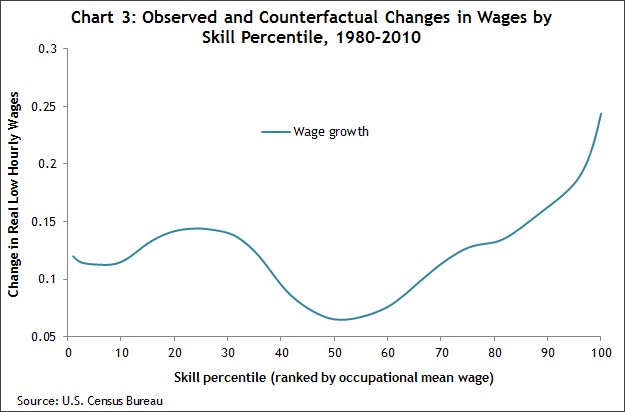
In a recent paper, Zlate and I study this issue (Mandelman and Zlate, 2013). Our hypothesis is that the sizable inflows of low-skilled immigration into the United States during the last 30 years weakened the increase of wages for this skill group. As noted earlier, service jobs at the bottom of the skill distribution cannot be offshored. However, immigration is an alternative. To see this, chart 4 shows the data depicted in chart 1, but separates the native from the foreign born. Basically, only low-skill occupations increase their share in total foreign employment. The growth in low-skill "service occupations" is a key factor explaining this. Foreign-born employment in this service sector increased 439 percent. Put differently, more than one-third of the jobs created in this sector went to foreign-born residents. Moreover, these numbers must be regarded as a lower bound, since it is difficult to properly account for undocumented immigrants in Census data.
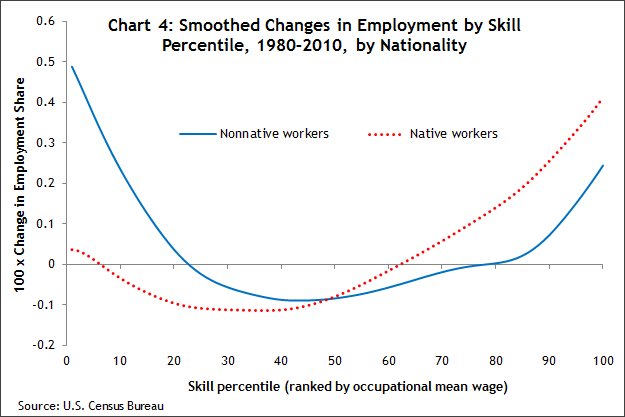
In Mandelman and Zlate (2013), we develop a multicountry model that features skill heterogeneity, offshoring, and unskilled labor migration within a general equilibrium context. In this dynamic specification, the household's optimizing behavior endogenously determines the extent of offshoring and immigration, as well as the amount of skill acquisition in response to changes in migration, trade policy, and macroeconomic shocks. The model is estimated with multilateral trade weighted indicators, U.S. border enforcement data on illegal migration, and macroeconomic data. Our preliminary quantitative results indicate that lowering barriers to trade and low-skill migration improve aggregate welfare in the destination country. Several factors can explain this. First, the economy becomes more productive as it specializes in tasks in that are more efficient. Second, even though migrants depress low-skill wages, they keep nontradable prices low (increasing the relative productivity of other workers). Third, and most interestingly, low-skill migration induces natives to train and acquire skills, thus increasing productivity. This last result is consistent with the empirical evidence in Hunt (2012), which finds that an increase in the share of immigrants significantly increases the probability that natives complete 12 years of schooling (even after controlling for endogeneity). Further details and directions for future research can be found in Mandelman and Zlate (2013).
By Federico S. Mandelman, Atlanta Fed research economist and associate policy adviser
Note: Fernando Rios-Avila provided superb research assistance.
References
Acemoglu, Daron and David Autor. 2010. "Skills, Tasks and Technologies: Implications for Employment and Earnings," in O. Ashenfelter and D. Card, eds. Handbook of Labor Economics, Volume 4.
Autor, David and David Dorn, 2013. "The Growth of Low Skill Service Jobs and the Polarization of the U.S. Labor Market." American Economic Review, forthcoming.
Firpo, Sergio, Nicole Fortin, and Thomas Lemieux. 2011. "Occupational Tasks and Changes in the Wage Structure." University of British Columbia, mimeo.
Grossman, Gene and Esteban Rossi-Hansberg. 2008. "Trading Tasks: A Simple Theory of Offshoring." American Economic Review, 98(5): 1978-1997.
Hunt, Jennifer, 2012. "The Impact of Immigration on the Educational Attainment of Natives." NBER Working Paper No. 18047.
Mandelman, Federico. 2013. "Labor Market Polarization and International Macroeconomic Dynamics." Federal Reserve Bank of Atlanta, mimeo.
Mandelman, Federico and Andrei Zlate. 2013. "Offshoring, Low-skilled Immigration and Labor Market Polarization." Federal Reserve Bank of Atlanta, mimeo.
Ottaviano, Gianmarco, Giovanni Peri, and Greg Wright, 2013. "Immigration, Offshoring and American Jobs." American Economic Review, forthcoming.


